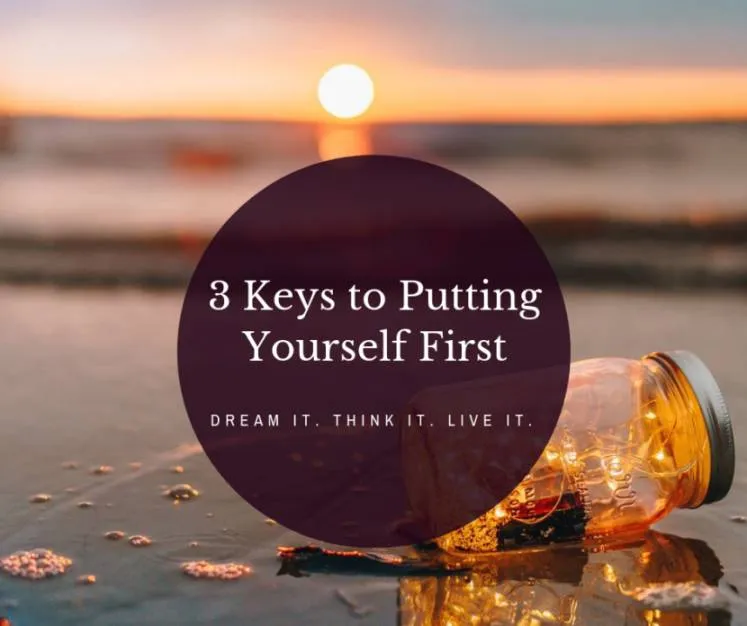So why is it that we seem to find a way to make everything other than ourselves a priority?
Working through lunch… Going home or sleeping through the alarm vs going to the gym… eating out vs cooking at home… name your excuse.
Is it that we don’t have time, or feel like we don’t have time?
Or, maybe it’s all up in our heads what we should do, but it never makes it in the planner?
Could it also be that it’s in your planner, but ‘things’ keep coming up that you keep having to reschedule?
In my recent Facebook Live Training, I shared 3 keys to help you put yourself first and bring meaning back into your life.
Let me just say I get that ‘things’ do come up, but just ask yourself: is this other thing really more important to your overall well being?
- Key #1 – Time Management, or in other words: Own your time, don’t let your time own you
- Key #2 – Planning & Organization because when you fail to plan, you plan to fail
- Key #3 – Prioritization & Scheduling… I mean how are you supposed to know what, or when to do what, if you don’t even know what you need and how important it is to you and your well being in the first place?
The 3 Keys
When you feel happy, it’s generally because your thoughts are happy…
…and your thoughts are happy generally because of something you did or did not do – an action.
So when you’re not balanced, or you don’t feel happy in an area(s) of your life, it’s generally because you’re not taking the right action to generate those feelings.
On that note, let’s get into it the keys, shall we?
Key #1: Time Management
What would you do if you had 30 hours of extra time? No, seriously.
It’s like this:
Everyone has 24 hours in a day, 7 days a week, which is 168 hours/week.
If let’s say, you slept 8 hours a night times that by 7 days, and that’s 56 hours. That still leaves 112 hours/week.
Let’s assume you work 42 hours a week.
Let’s assume too that you have 40 hours of free time to spend with family, at the gym, etc.
That leaves you with 30 hours left over!
What would you do with 30 hours of extra time?!
Homework
Do a time audit. How much time do you spend:
- sleeping?
- working?
- grocery shopping?
- spending time with family?
- spending time with friends?
- exercising?
- budgeting?
- planning?
- meditating?
- reading/learning?
- doing what you love?
Which brings us to Key # 2…
Key #2: Planning & Organizing
Failing to plan is planning to fail. Period.
Just think about that for a minute.
Let’s look at two scenarios:
Scenario 1:
You have a clearly laid out project or SMART goal.
You know exactly why you’re doing it, what your working towards, what to do, who’s doing what, milestones and when things needed to be done by.
You also have a mechanism in place to measure and track your progress and success. I’m willing to bet you feel pretty good about yourself, like unstoppable good!
Scenario 2:
You have no clarity around your project or goal.
No idea why you’re doing it or what the end outcome really is, no idea what you’re doing, or who’s doing what, when things are due, and therefore no idea whether what you are doing is on track or not.
In this scenario, I’m gonna say that you probably feel stressed, frustrated, lost, defeated, confused…and a whole other bunch of things that say I do not feel good.
So how can you plan effectively, so you are more in line with scenario 1?
The Rock, Pebbles, Sand Technique

If you’ve not heard of this, let me paint this with a story…
There was this professor, and one day he presented his class with a large empty jar, rocks, pebbles, and sand.
He first took the rocks, filled the jar with them, and then asked the class: Class, is the jar full? Yes, the class answered.
He then took the pebbles, filled the jar with them, even jiggled it around a bit so they fell in all the open spaces, and asked the class: Class, is the jar full? Yes, the class answered.
Then the professor took the sand, filled the jar right up to the top filling up any remaining crevices, and asked the class: Class, is the jar full now? Yes, the class answered.
What the professor was saying was that the jar represents your life, and the rocks, pebbles and sand represent everything in it.
The professor then went on to explain what the items signified:
ROCKS
- things that are truly important like family and health
- if the pebbles and the sand were lost, the jar would still be full and your life would still have meaning.
PEBBLES
- things in your life that no doubt matter, but that you could live without.
- pebbles are definitely things that give your life meaning (such as your job, house, hobbies, and friendships), but they are not critical for you to have a meaningful life.
- put another way, pebbles often come and go, and are not permanent or essential to your overall well-being.
SAND
- the rest of the things in your life, and material possessions.
- little things like watching TV or running errands.
- the things that don’t mean much to your life as a whole, and are likely only done to waste time or get small tasks accomplished.
The metaphor here is that if you start with putting sand into the jar, you will not have room for rocks or pebbles. The same is true with the things you let into your life.
If you spend all of your time on the small and insignificant things, you will run out of room for the things that are actually important.
So to have a more meaningful and efficient life, you gotta pay attention to the “rocks,” because they are critical to your long-term well-being.
- Pay attention to your health
- Spend time with your family
- Exercise regularly
- Keep in touch with relatives that live far away
Homework
Pick a max of 5 rocks, the most important things in your life.
Key #3: Prioritization & Scheduling
Now that you have the technique, how do you put it into action to get more balance, time, and productivity?
Categorize your life. First, you need a bird’s eye view of all the different areas in your life – health, family, business/career, friendship, romance, physical environment, self-development/learning, mindset/emotional health.. whatever you deem is important to your overall wellness.
List the activities under each category. Then you need to list the activities that you do regularly under each category. For example, under Health, I have exercise 5 times a week, grocery shopping and meal planning.
Prioritize. Label the activities as Rocks, Pebbles or Sand. Then group all the rocks, all the pebbles, and all the sand, and then prioritize each list in order of importance. Then create a master list, your prioritized rocks first, then pebbles, then sand. Keep this master list in the back of your planner, and revisit every 1-3 months.
Schedule. Pick one day a week and slot everything in to your planner. Make sure to leave space for extra time in case things come up, and just to have some breather time.
Homework
Do the exercise listed above over the next 3 months, and see how you feel. I encourage you to reflect on how you feel right now, and how you want to feel, and see how this exercise helps you achieve your feel goals. Feel Goals are great because you also want to make sure you’re feeling how you want to feel. If you’re not, then it’s a signal you need to make a change(s).
Before you go, I have some very exciting news to share.
Doors are now open to my 6 month Life Fulfillment Mentorship Program. Due to the in-depth work and coaching, there will only be 10 spaces available. Click below to learn more and apply today!

Until next time!
Join over 7,000+ and get on the Insider’s List for exclusive offers and updates!
[wd_hustle id=”email-subscribe” type=”embedded” css_class=””]




